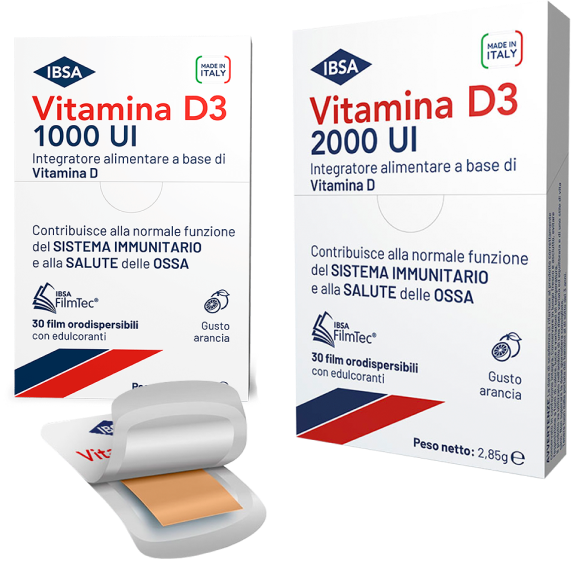La vitamina D è una sostanza fondamentale per la salute delle ossa e per la normale funzione del sistema immunitario. La fonte principale della vitamina D3, o colecalciferolo, è il sole, i cui raggi permettono la sintesi della vitamina D da parte della pelle, ma è presente anche in alcuni alimenti.
Nei casi di carenza di vitamina D, è raccomandato rivolgersi al proprio medico, che può consigliare l’assunzione di un integratore alimentare, come l’integratore Vitamina D3 IBSA.

Cos’è la Vitamina D?
La vitamina D è una sostanza in parte assunta attraverso il cibo e in gran parte sintetizzata dal nostro organismo grazie ai raggi solari.
Questa vitamina permette l’assorbimento del calcio, prezioso per mantenere le ossa sane, e regola i livelli di calcio e fosforo nel sangue. Ha inoltre un ruolo chiave nell’innescare la risposta immunitaria e nella funzione muscolare.
In particolare, la vitamina sintetizzata dalla pelle quando viene esposta ai raggi UVB del sole, è detta vitamina D3 o colecalciferolo.
Vitamina D e alimentazione
Per la maggior parte, la vitamina D viene sintetizzata dalla pelle tramite l’esposizione ai raggi solari. Ci sono però anche alimenti ricchi di questa vitamina come il pesce azzurro, i molluschi, i latticini e le uova. Se ne trovano tracce anche nella verdura a foglia verde, nei fagioli, nei funghi, nella frutta secca e nei cereali.

La carenza di vitamina D
La carenza di vitamina D è una condizione molto diffusa, dovuta ad una scarsa esposizione al sole o diminuito assorbimento.
I sintomi che possono comparire sono dolore alle ossa e ai muscoli, spossatezza e scarsa forza muscolare.
La vitamina D inoltre contribuisce alla normale funzione del sistema immunitario e una sua carenza può rendere più soggetti alle infezioni.
L’eccesso di vitamina D
La vitamina D viene accumulata nel fegato e rilasciata in piccole dosi al bisogno. Nei casi di eccesso si può avere nausea e vomito, perdita dell’appetito.

Integratore Vitamina D3 IBSA
L’Integratore di Vitamina D3 IBSA contribuisce alla normale funzione del sistema immunitario e alla salute delle ossa.
Nel pratico formato in film orodispersibile, realizzato grazie alla tecnologia FilmTec® IBSA, e al sapore di arancia, è ancora più facile da assumere. Il film ultrasottile, infatti, si scioglie in bocca in pochi secondi, senza bisogno di acqua. Senza lattosio e glutine, può essere assunto anche da chi ha esigenze alimentari specifiche.
L’integratore Vitamina D3 IBSA è prodotto in Italia senza OGM.

A cosa serve
la vitamina D?
A cosa serve la vitamina D?
La vitamina D è preziosa per la salute delle ossa e per il buon funzionamento del sistema immunitario. Permette all’organismo di assorbire il calcio, importante per lo sviluppo delle ossa e per mantenerle in salute e nel mantenere livelli adeguati di calcio e fosforo nel sangue.


